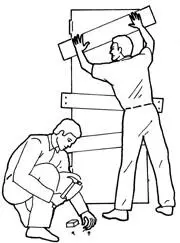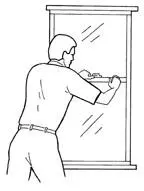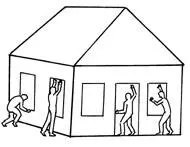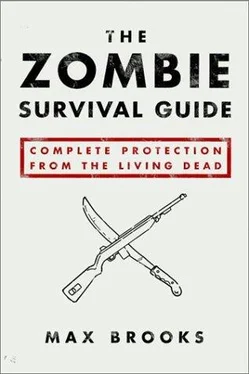
Security bars on doors and windows will stop a group of zombies for a limited amount of time. Experience has shown that as few as three walking dead can tear them down in less than twenty-four hours.

Tempered safety glass prevents entry by smashing but can be forced right out of its pane. This can easily be fixed by installing concrete or steel frames. However, the money it would take to replace each window in an average house could and should be spent instead on purchasing or building one of the two house types discussed above: stilted or tornado-proof domiciles.
A good ten-foot chain-link fence can hold dozens of zombies for weeks, even months, provided their numbers remain at Class 1. A ten-foot cinder-block wall, reinforced with steel rods and filled with concrete, is the safest barrier in both Class 1 and Class 2 outbreaks. Zoning laws may prohibit a wall this high, but don’t dismiss it. (Check with your local zoning board.) Although zombies have been known (on rare occasions) to hoist themselves over obstacles as high as six feet, this has never occurred en masse. Several people, well-armed and with good communication, can maintain a six-foot wall, not easily but safely, for as long as the stamina of this group holds out.
A gate should be steel or wrought-iron, solid if possible. It should slide to one side, not swing in or out. Reinforcement is as simple as parking your car up against it. Electric motors make opening easier but will leave you trapped in a power outage or breakdown.
As stated earlier, a ten-foot concrete wall will only provide adequate protection in a Class 1 or Class 2 outbreak. In a Class 3 outbreak, enough zombies can, and will, climb on top of each other until they form an undead ramp right over your wall.
C. Apartments
Apartments and apartment buildings vary in size and layout and, therefore, in defensibility. However, from the squat two-story buildings of Los Angeles to the concrete and glass towers of New York, certain basic rules apply.
First-floor apartments present the highest risk simply because of their accessibility. Tenants living above the ground floor are almost always safer than those in any type of house. Destroying the staircase effectively isolates the rest of the building. With the elevator turned off and the fire escape too high for a zombie to reach (strict limits are imposed by law), any apartment house can become an instant haven from the walking dead.
Another advantage of the apartment complex is its large population. Whereas a private homeowner may be forced to hold the residence by himself, an apartment building can be defended by all of its tenants. This also increases the chances of having multiple skilled experts such as carpenters, electricians, paramedics, and Army reservists (not always the case, but still a possibility). Of course, with additional people comes the challenge of additional social conflicts. This potential problem, however, should never be a deterrent when choosing between a house and an apartment. Given the choice, always pick the latter.
IMPORTANT NOTE: Discount Home-Defense Manuals!
Although almost every other section in this book encourages the use of conventional texts (on weapons use, military tactics, survival skills, and so on), those written to protect a domicile are not recommended. Home-defense books are designed to counter a human adversary with human skills and human intelligence. Many of the tactics and strategies featured in these books, such as employing elaborate alarm systems, booby traps, and painful, but nonlethal devices such as Mace canisters or nail heads in the carpet, would be useless against an undead intruder.
2. Preparation Part II: Supplies
Once the private residence is secure, stockpiling for a siege must be undertaken. There is no telling how long it will take for help to arrive. There is no telling if help ever will. Always be prepared for a long siege. Never assume a quick rescue.
A. Weapons
Whereas in the field you must travel light to maintain mobility, in your home you have the luxury of storing and maintaining a plethora of weapons. This does not mean filling your home with any capricious instrument of destruction. Each home arsenal should include:

* Rifle, 500 rounds
* Shotgun, twelve-gauge, 250 shells
* Pistol, .45 caliber, 250 rounds
* Silencer (rifle)
* Silencer (pistol)
* Heavy crossbow (in lieu of silencers), 150 bolts
* Telescopic sight (rifle)
* Night-vision scope (rifle)
* Laser sight (rifle)
* Laser sight (pistol)
* Katana sword
* Wakizashi or other short-bladed sword
* Two knives with smooth, six- to eight-inch blades
* Hand hatchet

(NOTE: This list applies to a single individual. Numbers should be adjusted depending on the number of people in the group.)
B. Equipment
Now that all weapons have been chosen, consider what equipment is necessary for your maintenance and perhaps even survival. In the short run, standard disaster-survival kits will suffice. Any longer, and the material below will be necessary. Common household items such as clothing, toilet paper, etc., are assumed to be kept on hand in reasonable quantities.
* Water, three quarts per day, for cooking and washing
* Hand-pumped water filter
* Four replacement filters
* Cistern for collecting rainwater
* Iodine and/or purification tablets
* Canned food, three cans per day (preferable to dried goods in that they contain some water)
* Two portable electric stoves
* Advanced medical kit (must include field-surgery implements and antibiotics)
* Bicycle-powered electric generator
* Gasoline generator (to be used only in emergencies)
* Twenty gallons of gasoline
* Rechargeable, battery-powered shortwave radio
* Two battery-powered flashlights
* Two rechargeable, battery-powered electric lamps
* Two rechargeable, battery-powered and/or solar-powered radios
* Appropriate reinforcement materials, including lumber, bricks, mortar, etc.
* Extensive tool kit, including sledgehammer, ax, handsaw, etc.
* Lime and/or bleaching powder in sufficient supply to maintain latrine
* One high-powered telescope (80X?100X), with spare lenses and cleaning equipment
* Fifteen emergency flares
* Thirty-five chemical light sticks
* Five fire extinguishers
* Two sets of earplugs
* Spare parts for all aforementioned machinery and user?s manuals
* Extensive library of manuals, including a general disaster manual
(NOTE: As with weapons, personal items such as food, water, and medicine must be multiplied for the number of people in your group.)
3. Surviving an Attack
The siege has commenced. Zombies swarm around your home, incessantly attacking but unable to enter. At this point, your worries are far from over. Waiting out a siege does not mean sitting idle. Many tasks will have to be accomplished and repeated for survival in a confined space.

A. Designate one corner of your backyard to serve as a latrine. Most survival manuals will explain the finer points of construction and disposal.
Читать дальше
















